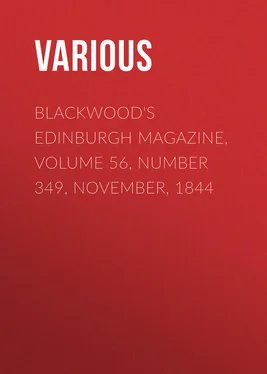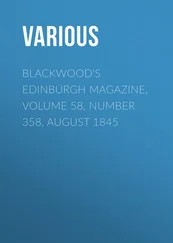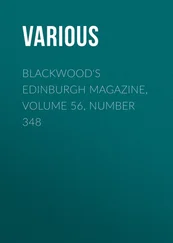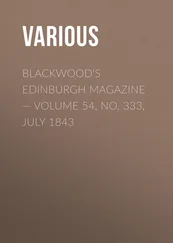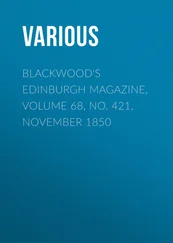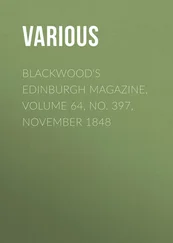Various - Blackwood's Edinburgh Magazine, Volume 56, Number 349, November, 1844
Здесь есть возможность читать онлайн «Various - Blackwood's Edinburgh Magazine, Volume 56, Number 349, November, 1844» — ознакомительный отрывок электронной книги совершенно бесплатно, а после прочтения отрывка купить полную версию. В некоторых случаях можно слушать аудио, скачать через торрент в формате fb2 и присутствует краткое содержание. Издательство: Иностранный паблик, Жанр: periodic, foreign_edu, Путешествия и география, на английском языке. Описание произведения, (предисловие) а так же отзывы посетителей доступны на портале библиотеки ЛибКат.
- Название:Blackwood's Edinburgh Magazine, Volume 56, Number 349, November, 1844
- Автор:
- Издательство:Иностранный паблик
- Жанр:
- Год:неизвестен
- ISBN:нет данных
- Рейтинг книги:4 / 5. Голосов: 1
-
Избранное:Добавить в избранное
- Отзывы:
-
Ваша оценка:
- 80
- 1
- 2
- 3
- 4
- 5
Blackwood's Edinburgh Magazine, Volume 56, Number 349, November, 1844: краткое содержание, описание и аннотация
Предлагаем к чтению аннотацию, описание, краткое содержание или предисловие (зависит от того, что написал сам автор книги «Blackwood's Edinburgh Magazine, Volume 56, Number 349, November, 1844»). Если вы не нашли необходимую информацию о книге — напишите в комментариях, мы постараемся отыскать её.
Blackwood's Edinburgh Magazine, Volume 56, Number 349, November, 1844 — читать онлайн ознакомительный отрывок
Ниже представлен текст книги, разбитый по страницам. Система сохранения места последней прочитанной страницы, позволяет с удобством читать онлайн бесплатно книгу «Blackwood's Edinburgh Magazine, Volume 56, Number 349, November, 1844», без необходимости каждый раз заново искать на чём Вы остановились. Поставьте закладку, и сможете в любой момент перейти на страницу, на которой закончили чтение.
Интервал:
Закладка:
2 2 State Prosecutions, pp. 9, 10. No. cccxxxix. Vol. lv.have proceeded by an ex-officio information at the suit of the crown, filed by the Attorney-General; but in this instance, waiving all the privileges appertaining to the kingly office, they appeared before the constituted tribunal of the law as the redressers of the public wrongs, invested however with no powers or authority beyond the simple rights enjoyed by the meanest of its subjects – and preferred an indictment : which is "a written accusation of one or more persons, of a crime or misdemeanour, preferred to and presented on oath by a grand jury."
3 3 Blackstone's Commentaries, vol. i. p. 302.Now, in framing an indictment, the following are the principles to be kept in view. They were laid down with beautiful precision and terseness by Lord Chief-Justice De Grey, in the case of Rex. v. Horne – 2 Cowper's Rep. 682.
"The charge must contain such a description of the crime, that the defendant may know what crime it is which he is called upon to answer; that the jury may appear to be warranted in their conclusion of 'guilty,' or 'not guilty,' upon the premises delivered to them; and that the court may see such a definite crime, that they may apply the punishment which the law prescribes."
There may be, and almost always are, several, sometimes many, counts in a single indictment; and it is of peculiar importance in the present case, to note the reason why several counts are inserted, when the indictment contains a charge of only one actual offence. First, when there is any doubt as to which is the proper mode, in point of law , of describing the offence; secondly, lest, although the offence be legally described on the face of the indictment, it should be one which the evidence would not meet or support. The sole object is, in short, to avoid the risk of a frequent and final failure of justice on either of the above two grounds. Technically speaking, each of these counts is regarded (though all of them really are only varied descriptions of one and the same offence) as containing the charge of a distinct offence. 4 4 Several distinct offences may undoubtedly be included, in as many counts, in one indictment.
For precisely the same reason, several counts were, till recently, allowed in civil proceedings, although there was only one cause of action; but this license got to be so much abused, (occasioning expensive prolixity,) that only one count is now permitted for one cause of action – a great discretion being allowed to judge, however, by statute, of altering the count at the trial, so as to meet the evidence then adduced. A similar alteration could not be allowed in criminal cases, lest the grand jury should have found a bill for one offence, and the defendant be put upon his trial for another. There appear, however, insuperable objections to restricting one offence to a single count, in respect of the other object, on peril of the perpetual defeat of justice. The risk is sufficiently serious in civil cases, where the proceedings are drawn so long beforehand, and with such ample time for consideration as to the proper mode of stating the case, so as to be sufficient in point of law. But criminal proceedings cannot possibly be drawn with this deliberate preparation and accurate examination into the real facts of the case beforehand; and if the only count allowed – excessively difficult as it continually is to secure perfect accuracy – should prove defective in point of law, the prisoner, though guilty, must either escape scot-free, or become the subject of reiterated and abortive prosecution – a gross scandal to the administration of justice, and grave injury to the interests of society. If these observations be read with attention, and borne in mind, they will afford great assistance in forming a clear and correct judgment on this remarkably interesting, and, as regards the future administration of justice , vitally important case. There is yet one other remark necessary to be made, and to be borne in mind by the lay reader. Adverting to the definition already given of a "conspiracy" – that its essence is the mere agreement to do an illegal act – it will be plain, that where such an agreement has once been shown to have been entered into, it is totally immaterial whether the illegal act, or the illegal acts, have been actually done or not in pursuance of the conspiracy. Where these illegal acts, however, have been done, and can be clearly proved, it is usual – but not necessary – to set them out in the indictment for a conspiracy. This is called setting out the overt acts , (and was done in the present instance,) not as any part of the conspiracy, but only as statements of the evidence by which the charge was to be supported – for the laudable purpose of giving the parties notice of the particular facts from which the crown intended to deduce the existence of the alleged conspiracy. They consisted, almost unavoidably, of a prodigious number of writings, speeches, and publications; and these it was which earned for the indictment the title of "the Monster Indictment." It occupies fifty-three pages of the closely printed folio appendix to the case on the part of the crown – each page containing on an average seventy-three lines, each line eighteen words; which would extend to nine hundred and fifty-three common law folios , each containing seventy-two words! The indictment itself, however, independently of its ponderous appendages, was of very moderate length. It contained eleven counts – and charged a conspiracy of a five-fold nature — i. e. to do five different acts; and the scheme of these counts was this: – the first contained all the five branches of the conspiracy – and the subsequent counts took that first count to pieces; that is to say, contained the whole or separate portions of it, with such modifications as might appear likely to obviate doubts as to their legal sufficiency, or meet possible or probable variations in the expected evidence . The following will be found a correct abstract of this important document.
The indictment, as already stated, contained eleven counts, in each of which it was charged that the defendants, Daniel O'Connell, John O'Connell, Thomas Steele, Thomas Matthew Kay, Charles Gavan Duffy, John Gray, and Richard Barrett, the Rev. Peter James Tyrrell, and the Rev. Thomas Tierney, unlawfully, maliciously, and seditiously did combine, conspire, confederate, and agree with each other, and with divers other persons unknown, for the purposes in those counts respectively stated.
The first count charged the conspiracy as a conspiracy to do five different acts, (that is to say,)
" First. To raise and create discontent and disaffection amongst her Majesty's subjects, and to excite such subjects to hatred and contempt of the government and constitution of the realm as by law established, and to unlawful and seditious opposition to the said government and constitution.
" Second. To stir up jealousies, hatred, and ill-will between different classes of her Majesty's subjects, and especially to promote amongst her Majesty's subjects in Ireland, feelings of ill-will and hostility towards and against her Majesty's subjects in the other parts of the United Kingdom, especially in that part of the United Kingdom called England.
" Third. To excite discontent and disaffection amongst divers of her Majesty's subjects serving in her Majesty's army.
Читать дальшеИнтервал:
Закладка:
Похожие книги на «Blackwood's Edinburgh Magazine, Volume 56, Number 349, November, 1844»
Представляем Вашему вниманию похожие книги на «Blackwood's Edinburgh Magazine, Volume 56, Number 349, November, 1844» списком для выбора. Мы отобрали схожую по названию и смыслу литературу в надежде предоставить читателям больше вариантов отыскать новые, интересные, ещё непрочитанные произведения.
Обсуждение, отзывы о книге «Blackwood's Edinburgh Magazine, Volume 56, Number 349, November, 1844» и просто собственные мнения читателей. Оставьте ваши комментарии, напишите, что Вы думаете о произведении, его смысле или главных героях. Укажите что конкретно понравилось, а что нет, и почему Вы так считаете.
